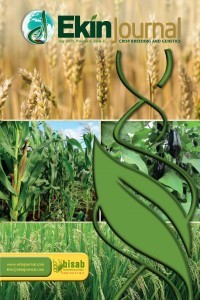Determination of Superior Turkish Eggplant (Solanum melongena L.) Genotypes by Pedigree Selection Method
Determination of Superior Turkish Eggplant (Solanum melongena L.) Genotypes by Pedigree Selection Method
Solanum melongena, genetic resources, selection, Turkey,
___
- Balkaya A and Yanmaz R (2001). Bitki genetik kaynak- larının muhafaza imkanları ve tohum gen banka- larının çalışma sistemleri. Ekoloji Çevre Dergisi, 10(39): 25-30 (In Turkish).
- Balkaya A and Yanmaz R (2005). Promising kale (Brassica oleracea var. acephala) populations from Black Sea region, Turkey. New Zealand Journal of Crop and Horticultural Science, 33(1): 1-7.
- Balkaya A and Ergün A (2008). Diversity and use of pinto bean (Phaseolus vulgaris) populations from Samsun, Turkey, New Zealand Journal of Crop and Horticultural Science, 36: 189-197.
- Balkaya A, Kurtar ES, Yanmaz R and Özbakır M (2011). Karadeniz Bölgesi kestane kabağı (Cucurbita maxima) populasyonlarından seleksiyon ıslahı yoluyla geliştirilen çeşit adayları. Türkiye IV. Tohumculuk Kongresi. Bildiriler Kitabı-1. 17-22 (In Turkish).
- Bliss FA (1981). Utilization of vegetable germplasm (Ploidy levels). HortScience 16(2): 129-132.
- Boyacı HF, Topçu V and Abak K (2010). Burdur Göl pat- lıcanı populasyonlarında morfolojik özelliklerde çeşitlilik. VIII. Sebze Tarımı Sempozyumu, 23-26 Haziran, Van, 255-260 (In Turkish).
- Cakir Z, Balkaya A, Saribas S and Kandemir D (2017). The morphological diversity and fruit characterization of Turkish Eggplant (Solanum melongena L.) populations. Ekin Journal of Crop Breeding and Genetics, 3(2): 34-44.
- Çakır Z (2018). Patlıcanda (Solanum melongena L.) yerel genetik kaynakların karakterizasyonu ve seleksiyon ıslahı ile çeşit ıslah programlarında değerlendirilmesi. Ondokuz Mayıs Üniversitesi Fen Bilimleri Enstitüsü, Bahçe Bitkileri Anabilim Dalı, Yüksek Lisans Tezi, 92 s (In Turkish).
- Çetinkaya S, Yılmaz S, Arı N, Ünlü A, Fırat AF, Teksam I, Zengin S, Çelik I, Öztop A, Devran Z, Kaya N, Sayın B, Çelikyurt MA and Aktas A (2009). Örtüaltı Patlıcan Yetiştiriciliği. Batem Akdeniz Tarımsal Araştırma Enstitüsü, Antalya (In Turk- ish).
- Daunay MC, Lester RN, Gebhardt C, Hennart W, Jahn M and Doganlar S (2001). Genetic resources of eggplant (Solanum melongena L.) and allied spe- cies: a new challenge for molecular geneticists and eggplant breeders. Nijmegen University Press, Nijmegan, The Netherlands, pp: 251-274.
- Engels JMM, Arora RK and Guarino L (1995). An introduction to plant germplasm exploration ollecting: planning, methods and procedures, follow-up. Collecting plant genetic diversity. Technical guidelines. CAB International, Wallingford, United Kingdom, 31-63 pp.
- FAO (2016). Food and Agriculture Organization. http:// www.fao.org/faostat/en/#data/QC (Accessed on 19.12.2017).
- Filiz N and Özçalabı A (1992). Bazı patlıcan çeşitlerinin fenolojik, morfolojik ve pomolojik özellikleri üzerinde araştırmalar. I. Ulusal Bahçe Bitkileri Kongresi, 2: 197-199 (In Turkish)
- Frary A, Doganlar S and Daunay MC (2005). “Eggplant”, Genome Mapping and Molecular Breeding in Plants, 5: 231-257.
- Fukuoka H, Yamaguchi H, Nunome T, Negoro S, Miyatake K and Ohyama A (2010). Accumulation, functional annotation, and comparative analysis of expressed sequence tags in eggplant (Solanum melongena L.), the third pole of the genus Solanum species after tomato and potato. Gene, 450(1): 76-84.
- Kalloo G (1993). Eggplant. in: “Genetic Improvement of Vegetable Crop”. Kalloo,G. and B.Bergh (eds) Pergamon press, Oxford, 587-604.
- Kaplan N and Koludar J (1986). Güneydoğu Anadolu Tarımsal Araştırma Enstitüsü, 1986 Yılı Faaliyet Raporu, 349-350 (In Turkish).
- Karaağaç O and Balkaya A (2017). Türkiye’de yerel sebze çeşitlerinin mevcut durumu ve ıslah pro- gramlarında değerlendirilmesi. TÜRKTOB Der- gisi, 23(6): 8-15 (In Turkish).
- Küçük SA (2003). Solanaceae genetic resources activities in Turkey. National Collections. Solanaceae Genetic Resources in Europe. Report of two meetings 21 September 2001, Nijmegen, The Netherlands. 22 May 2003, Skierniwice, Poland.
- Pirinç V (1999). Şanlıurfa yerel patlıcan populasyon- larının kendilenmiş hatlarıyla karşılaştırılması üzerinde bir araştırma. Harran Üniversitesi Fen Bilimleri Enstitüsü Bahçe Bitkileri Anabilim Dalı, Yüksek Lisans Tezi, 76 s (In Turkish).
- Pirinç V and Pakyürek AY (2004). A study on comparison of eggplant population with their selfing lines. International Journal of Agriculture and Biology, 6(5): 874-876.
- Topçu V (2014). Kendileme yoluyla saflaştırılmış bazı patlıcan hatlarının morfolojik ve moleküler karak- terizasyonu. Süleyman Demirel Üniversitesi Fen Bilimleri Enstitüsü Bahçe Bitkileri Anabilim Dalı, Yüksek Lisans Tezi, 82 s (In Turkish).
- TUIK (2016). Turkish Statistical Institute Statistical Data (Accessed on 19.12.2017).
- Tümbilen Y (2007). Determination of genetic diversity between eggplant and its wild relatives. Master Thesis. The Graduate School of Engineering and Sciences of İzmir Institute of Technology, Molec- ular Biology and Genetics, 76 p.
- Vural H, Esiyok D and Duman I (2000). Cultivated vegetables (Vegetable production). Ege University, Bornova, Izmir.
- ISSN: 2149-1275
- Yayın Aralığı: Yılda 2 Sayı
- Başlangıç: 2015
- Yayıncı: Bitki Islahçıları Alt Birliği
Prospects of Advanced Genomics for Development of Climate Resilient Wheat Genotypes
Surender KHATODIA, Kirti BHATOTIA, Rishi K. BEHL
Emel OZER, Nurcan Akay GURBUZ, Nurdilek GULMEZOGLU
Potential of Trakya Region for Production of Triticale
İsmet BASER, Zahit Kayihan KORKUT, Alpay BALKAN, Oguz BILGIN
İsmet BASER, Zahit Kayihan KORKUT, Alpay BALKAN, Levent OZDUVEN, Oguz BILGIN
Seyma SARIBAS, Zuleyha CAKIR, Ahmet BALKAYA, Dilek KANDEMIR
Zinnur GOZUBUYUK, Okan DEMIR, Ahmet KUCUKOZDEMIR
Evaluation of Yield and Some Agro-Morphological Characters of Triticale Genotypes in Trakya Region
İrfan OZTURK, Turhan KAHRAMAN, Remzi AVCI, Sahinde SILI, Tugba Hilal KILIC, Adnan TULEK
